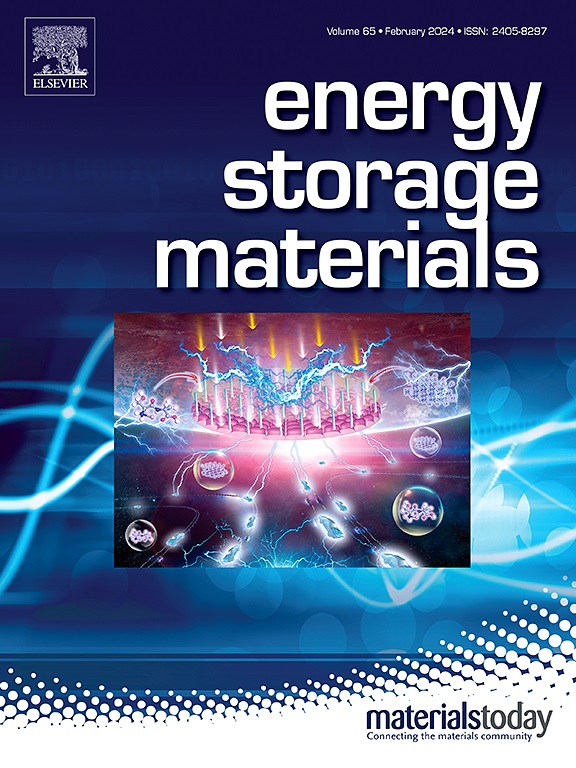Membrane contamination-driven sulfonate structuring for enhanced stability in all-iron redox flow batteries
IF 18.9
1区 材料科学
Q1 CHEMISTRY, PHYSICAL
引用次数: 0
Abstract
All-soluble all-iron redox flow batteries are considered a promising long-duration, large-scale energy storage technology due to their fully decoupled energy and power design and low-cost active materials. However, the anode requires chelating ligands with electron-donating capabilities to establish a potential difference with ferrocyanide, but ligand crossover results in their oxidation, which subsequently causes failure and restricts stable operation. This work proposes a method based on K+-induced aggregation of sulfonate groups in perfluorosulfonic acid membranes, eliminating the need for additional additives. By cycling the membrane through the flow battery process, the barrier effect against anode ligands is enhanced, enabling stable cycling for 3227 cycles at 80 mA/cm² and ensuring long-term stability. Molecular dynamics simulations and cross-membrane diffusion experiments reveal the impact of different metal cations on the morphology of water channels in the membranes. A Na+-exchange membrane treated with K+ from the electrolyte achieves a high average energy efficiency of 73.4 %, maintaining battery stability. This work provides a simple yet effective strategy to improve the stability of all-soluble all-iron redox flow batteries. By uncovering the underlying microscopic mechanisms through simulations, it paves the way for the practical implementation of this technology in large-scale energy storage systems.

膜污染驱动的磺酸盐结构增强全铁氧化还原液流电池的稳定性
全可溶性全铁氧化还原液流电池由于其完全解耦的能量和功率设计以及低成本的活性材料,被认为是一种有前途的长寿命、大规模储能技术。然而,阳极需要具有给电子能力的螯合配体来与亚铁氰化物建立电位差,但配体交叉导致其氧化,从而导致失效并限制稳定运行。这项工作提出了一种基于K+诱导的全氟磺酸膜中磺酸基团聚集的方法,消除了对额外添加剂的需要。通过在液流电池过程中循环膜,增强了对阳极配体的屏障效应,能够在80 mA/cm²的速度下稳定循环3227次,并确保长期稳定性。分子动力学模拟和跨膜扩散实验揭示了不同金属阳离子对膜内水通道形态的影响。电解液中的K+处理后的Na+交换膜的平均能量效率达到73.4%,保持了电池的稳定性。这项工作为提高全溶性全铁氧化还原液流电池的稳定性提供了一种简单而有效的策略。通过模拟揭示了潜在的微观机制,为该技术在大规模储能系统中的实际应用铺平了道路。
本文章由计算机程序翻译,如有差异,请以英文原文为准。
求助全文
约1分钟内获得全文
求助全文
来源期刊

Energy Storage Materials
Materials Science-General Materials Science
CiteScore
33.00
自引率
5.90%
发文量
652
审稿时长
27 days
期刊介绍:
Energy Storage Materials is a global interdisciplinary journal dedicated to sharing scientific and technological advancements in materials and devices for advanced energy storage and related energy conversion, such as in metal-O2 batteries. The journal features comprehensive research articles, including full papers and short communications, as well as authoritative feature articles and reviews by leading experts in the field.
Energy Storage Materials covers a wide range of topics, including the synthesis, fabrication, structure, properties, performance, and technological applications of energy storage materials. Additionally, the journal explores strategies, policies, and developments in the field of energy storage materials and devices for sustainable energy.
Published papers are selected based on their scientific and technological significance, their ability to provide valuable new knowledge, and their relevance to the international research community.
 求助内容:
求助内容: 应助结果提醒方式:
应助结果提醒方式:


